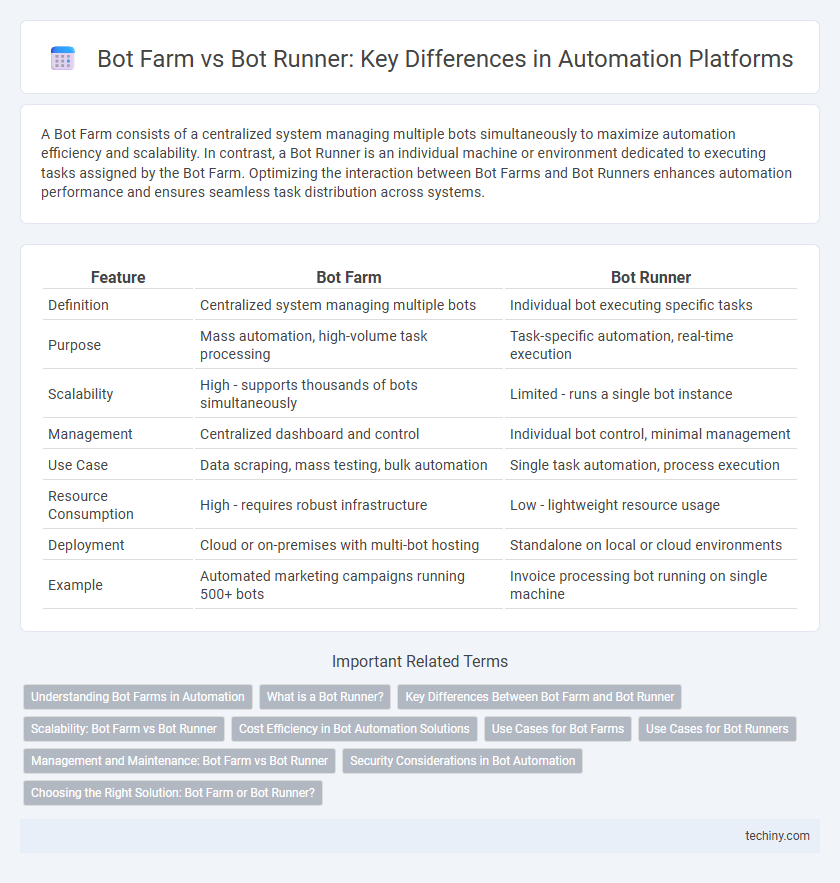A Bot Farm consists of a centralized system managing multiple bots simultaneously to maximize automation efficiency and scalability. In contrast, a Bot Runner is an individual machine or environment dedicated to executing tasks assigned by the Bot Farm. Optimizing the interaction between Bot Farms and Bot Runners enhances automation performance and ensures seamless task distribution across systems.
Table of Comparison
| Feature | Bot Farm | Bot Runner |
|---|---|---|
| Definition | Centralized system managing multiple bots | Individual bot executing specific tasks |
| Purpose | Mass automation, high-volume task processing | Task-specific automation, real-time execution |
| Scalability | High - supports thousands of bots simultaneously | Limited - runs a single bot instance |
| Management | Centralized dashboard and control | Individual bot control, minimal management |
| Use Case | Data scraping, mass testing, bulk automation | Single task automation, process execution |
| Resource Consumption | High - requires robust infrastructure | Low - lightweight resource usage |
| Deployment | Cloud or on-premises with multi-bot hosting | Standalone on local or cloud environments |
| Example | Automated marketing campaigns running 500+ bots | Invoice processing bot running on single machine |
Understanding Bot Farms in Automation
Bot farms are centralized systems designed to deploy and manage large numbers of bots simultaneously to perform automated tasks at scale. Unlike bot runners, which execute individual bots or specific processes independently, bot farms coordinate multiple bots to maximize efficiency and handle complex workflows in automation environments. Understanding bot farms is crucial for optimizing resource allocation, monitoring performance, and ensuring secure, scalable automation deployments.
What is a Bot Runner?
A Bot Runner is a virtual or physical machine that executes automated tasks or processes designed by automation software within a Bot Farm environment. It acts as the operational unit where bots run scripts, interact with applications, and perform repetitive tasks, enabling scalable automation workflows. High-performance Bot Runners optimize task execution speed and reliability, enhancing overall automation efficiency.
Key Differences Between Bot Farm and Bot Runner
A Bot Farm is a centralized environment hosting numerous bots designed to perform multiple automation tasks simultaneously, whereas a Bot Runner is an individual bot instance that executes these automated processes on a specific machine or environment. Bot Farms enable scalable deployment and management of bots, optimizing resource allocation and operational efficiency. In contrast, Bot Runners focus on task execution, relying on Bot Farms for orchestration and workload distribution.
Scalability: Bot Farm vs Bot Runner
Bot Farms offer superior scalability by managing numerous Bot Runners simultaneously, enabling large-scale automation across complex workflows. Bot Runners execute specific tasks assigned by the Bot Farm, which optimizes resource allocation and load balancing to enhance performance. This hierarchical structure allows enterprises to scale automation efforts efficiently while maintaining centralized control and monitoring.
Cost Efficiency in Bot Automation Solutions
Bot Farms enable large-scale automation by managing numerous bots simultaneously, significantly reducing operational costs through centralized control and resource sharing. Bot Runners, in contrast, execute individual bot tasks and can incur higher cumulative expenses when scaled due to separate infrastructure and licensing fees. Choosing Bot Farms enhances cost efficiency by optimizing resource allocation and minimizing maintenance overhead in bot automation solutions.
Use Cases for Bot Farms
Bot Farms are centralized infrastructures designed to deploy and manage large volumes of bots simultaneously, optimizing scalability for enterprise automation tasks like data scraping, social media management, and bulk content generation. Unlike Bot Runners, which execute individual bots on local machines or isolated environments, Bot Farms enable parallel processing and high-throughput automation workflows essential for handling massive repetitive operations efficiently. Use cases for Bot Farms include web indexing, automated testing across multiple platforms, and monitoring extensive digital asset networks, providing robust resource management and enhanced operational control.
Use Cases for Bot Runners
Bot Runners specialize in executing automation tasks on designated machines, making them ideal for scalable deployment in environments requiring high-volume process automation such as data extraction, batch processing, and repetitive desktop operations. Unlike Bot Farms that centralize orchestration and scheduling, Bot Runners excel in distributed task execution, enabling organizations to enhance operational efficiency across multiple endpoints. Use cases include robotic process automation (RPA) for customer service workflows, automated report generation, and system monitoring tasks that demand consistent, error-free execution.
Management and Maintenance: Bot Farm vs Bot Runner
Bot Farm management involves overseeing a large-scale infrastructure of automated bots, requiring centralized control systems for deployment, monitoring, and load balancing to ensure optimal performance and minimal downtime. Bot Runner maintenance focuses on individual instances of bots, emphasizing regular updates, error handling, and resource optimization to maintain smooth task execution. Effective automation strategies balance the comprehensive oversight of Bot Farms with the granular upkeep of Bot Runners for scalable and reliable operations.
Security Considerations in Bot Automation
Bot farms centralize large volumes of automated bots, increasing vulnerability to attacks if compromised, while bot runners operate individual or smaller sets of bots, reducing the attack surface. Security considerations in bot automation emphasize strict access controls, encrypted communications, and continuous monitoring to prevent unauthorized bot deployment and data breaches. Implementing role-based permissions and integrating multi-factor authentication enhances protection against bot exploitation and malicious bot behavior.
Choosing the Right Solution: Bot Farm or Bot Runner?
Selecting between Bot Farm and Bot Runner depends on the scale and complexity of automation needs. Bot Farms excel in handling high-volume, parallel task execution across multiple bots, ideal for enterprises requiring large-scale, distributed automation. Bot Runners are suited for environments where individual bot execution control, real-time monitoring, and flexible integration with existing systems are critical.
Bot Farm vs Bot Runner Infographic

 techiny.com
techiny.com